Spain, October 11-18, 2007
Chinchon, October 11-14
 |
 |
We take a week off and visit our friends Nik and Waki, and their lovely 2-year old daughter Lila, in Chinchon, Spain. We saw our friends last time in the aftermath of nine-eleven when the couple was leaving Bloomington after Nik's graduation. We've been in email contact since then. I can't believe it's been six years! |
Our first day in Chinchon is Columbus day (Dia de la Hispanidad), a national holiday to celebrate Christopher Columbus' discovery of the Americas. Chinchon is a beautiful town of 4000 people, and famous for garlic and anise liquor. |
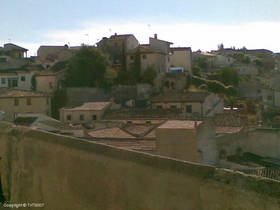 |
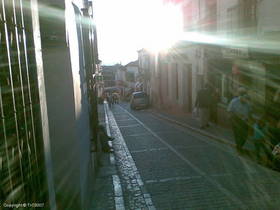 |
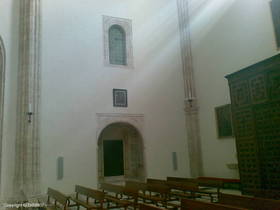 |
However, there is not much to do in Chinchon but wander the cobble stone streets, visit churches, and go shopping (for garlic and anise liquor). We spend the first half of the national holiday in the city. We walk to the Plaza Mayor, which is currently occupied by a temporary bull fighting arena. |  |
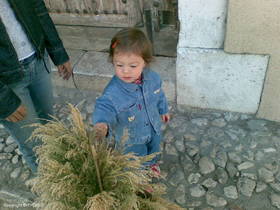 |
Then we head out to the castle,
which is deserted at the moment. All this takes a lot of time, since
the two-year old in our company finds so many interesting things on
the ground we others could never imagine.
This reminds me of Douglas Hofstadter's talk I heard in Indiana a few years ago: he was telling about the family trip to Grand Canyon, and how the parents had a hard time getting their small kid interested in the spectacular view over the canyon. For him every small and different cockroach roaming in the sand was amazing enough. Without going into details, Doug's explanation to the phenomenon was based on chunking. |
|
| In the afternoon we go for a walk with Nik to the surrounding fields. 'Fields' is kind of a misnomer: the terrain is pretty rough and rugged, and almost nothing grows there. Still some fig and olive trees survive. The figs are ripe (we taste them), but olives are not (Nik tells they are harvested in the Spring): still Tomi takes a bite and frowns. |  |
 |
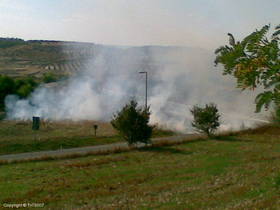 |
When heading out of town we see a fire consuming the roadside flora; someone probably threw a burning cigarette out of the car, which is really detrimental given the dryness of the ground. |
 |
| We start the next day (Saturday) by running. At 8:30AM the sun has barely risen, and it is really chilly. There is supposed to be a road around the town we could run. We feel more adventurous and take a small dirt road a little further. Not sure if it is going to turn around, we cross a olive tree plantation and climb a hill to the nearest paved road that takes us back. Not too many people are up at this time of the day: a couple of old fellows standing at the street corners and a Catholic monk on his way somewhere. | 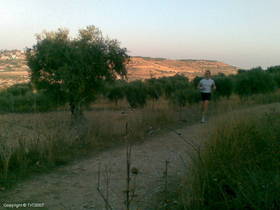 |
 |
|
By the time we are back our hosts have gotten up. We arrange for
a day trip to Aranjuez, a touristy town 20 minutes away from Chinchon.
In Aranjuez we visit the royal castle ( Palacio Real de Aranjuez), that was built as a vacation home for the royal family in 1500's. I have never seen as eclectic combination of styles and tastes in a single building. Every room is overly decorative with A LOT of details, pictures, and colors. The most amazing one is the room with pictures on the wall that are not painted, but made of porcelain. |
||
| When returning from the castle we are already hungry. It is about the time to have lunch. We had reserved a table in a restaurant, whose name I don't remember, on our way to Aranjuez. We share some green salad to start with and then mixed paella with vegetables (very little, though), chicken and seafood. Always so adventurous Lila wants to have all the shellfish. We finish with some local herb liqueur (not Lila). | 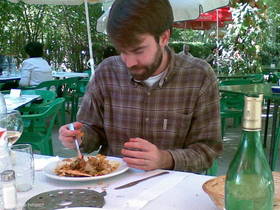 | |
 |
The rest of the afternoon is spent in the nearby gardens running after Lila, who collects --- besides feathers, her favorite --- chestnuts, flowers, and tree branches. She also likes to push her daddy around in her stroller. | 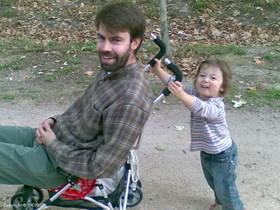 |
| On Sunday we don't do much: first we go shopping for food and wine, and then spend the lazy afternoon BBQing on Waki and Nik's patio. After eating we go for more treasure hunting with Lila. |  |
 |
| On Monday morning Nik takes us to the train station nearby Madrid,
from where we catch the train (and then the metro) to the airport. The plan for
the next three days is to rent a car (which we have already reserved at
Hertz) and visit some interesting places. We have Segovia and Toledo in mind.
The start of the trip does not go smoothly: despite being very new and shiny, the train system has some problems. When leaving the airport we miss a turn and the next moment we are in the middle of the Madrid's lunchtime traffic. |
||
Segovia and Toledo, October 15-17
 |
Segovia and Toledo are pretty much alike, both are old towns with narrow, curvy, and steep cobble stone streets, a lot of dead-end alleys leading to stairs, restaurants, cathedrals, and fortresses (Alcazar). Both are also located on a hill. Segovia has old Roman aqueduct as an attraction. Toledo is more touristy and its old town is larger, and even more hazardous to drive. In Segovia we pay 46 euros for a room in Hostal Don Jaime, and 3.50 each for breakfast. In Toledo we stay next to the cathedral in Casa de Cisneros for 80 euros, breakfast included. |
|
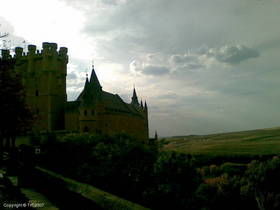 |
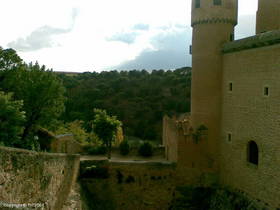 |
So, what do we do in these towns? Nothing much besides walking the streets back and forth, eating and having some wine and beer: Spanish light lager is not bad at all, and wine is inexpensive. |
 |
In Segovia we actually have a dinner at restaurant Jose: overpriced, unimaginative, and bad service. In Toledo we opt for having tapas here and there: it works much better that way. | 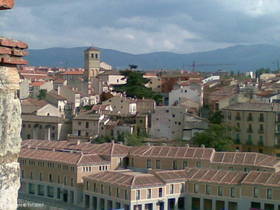 |
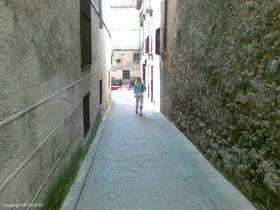 |
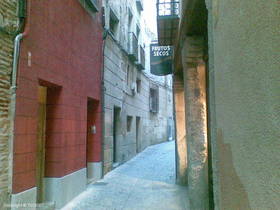 |
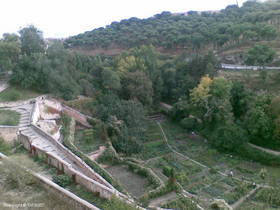 |
| On Tuesday morning we head out for a run in Segovia. There is a trail that goes around the town down by the river. It takes time to find the trail first. In other words, we have to take quite a few steps down in order to reach the river. Then it is a nice run from there. However, we notice the altitude: Segovia is about 1000 meters above the sea level. |  |
 |
 |
We leave Segovia in the late morning to cross the mountains to El Escorial. On our way we stop for a cafe solo and vegetarian sandwich in Pto de Navacerrada, a ski resort located up in 1880 meters. |  |
 |
 |
We do not stop at El Escorial, but directly continue to Archaeological Park of Carranque. The site dates back in 400's and contains the remains of a building called "Basilico" with exceptional marble columns carved in Greece and Turkey. Another building called "Villa Materno" has most of its mosaic floor tiling intact. The site was discovered as recently as 1983. |
| From Carranque we take a curious toll road to Toledo: it is brand new (opened this year) and there is no one there. We stop at a gas station for some sandwiches and water (no one there either). The clerk even speaks fair English. | 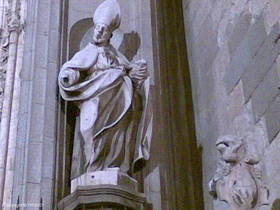 |
 |
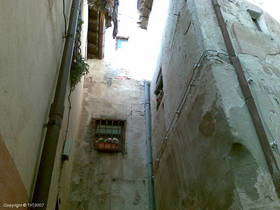 |
 |
We plan to visit our friends in Chinchon once more, so we leave Toledo by noon on Wednesday. We take all the smallest roads, some of them which may not be called roads in some standards. In general, the Spaniards are doing fine job in keeping their highways and even smaller roads in an excellent condition. The surface is smooth and shoulders wide: true heaven for bicyclists, which we saw several, not touring though. |
We visit a few small towns on our way looking for a place for lunch. As the lunch time is coming to an end, eventually we find ourselves in Villarejo de Salvanes, and a place called Restaurante venta de Lepanto. We order a la carte, and get some extra treats from the host. The only downside of the experience is the table next to us: a party of 15 or so women and most of them smoking. |
||
 |
Before hitting the unpaved country roads, we pass the town of Villarrubia de Santiago (we actually stop at the square and take a peek at the church), and its tens of windmills, which for some reason are not operating even if there is a recognizable breeze. Another town (Huerta de Valdecarabanos?) we drive through earlier has a number of solar panels on the nearby hill. |  |
|
In our last night in Spain we have a shopping spree. Waki and Lila accompany us. We buy some olive oil (organic and local), garlic, wine, olives, organic shampoo and soap, chorizo, Limoncillo (also local), and some more olive oil. All the bottles survived the flight home. Finally, here is a list of miscellaneous observations made throughout the trip, in random order and accompanied with miscellaneous photos that look more like paintings to me (note, all the pictures were taken with a cell phone camera): | ||
| As said, the Spanish highways are in really good shape.
The traffic may be nerve breaking, though. Some drivers obey the speed limits and some go way over it, and they do not hesitate to pass on curvy and hilly roads in dark. |
Drivers appreciate pedestrians and always yield if someone is trying to use the pedestrian crossing. I guess this is the law in Spain (as if it weren't here :-( | Food and cosmetics cost in supermarkets as much as in Finland, with the
exception of wine, of course.
Food is fatty and salty, mostly protein and carbs, no fiber whatsoever. But where are the famous fresh Spanish vegetables? The best food we ate was cooked by our Japanese-American hosts in Chinchon. |
| I have never seen so many roundabouts and speed bumps anywhere. There were
roundabouts every few hundred meters in major highways and roads,
especially in the proximity of cities.
Another plus to Spanish road system: all the roads and crossings are well marked. It is very hard to get lost on the major highways. But if you go off the beaten path, you can't be sure anymore. However, the lesser roads seem to be well marked in maps, too. The only thing left for the driver is to figure out if still on the road or in the corn field. |
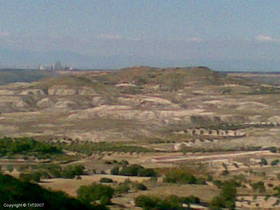 |
Spaniards love fragrances, both men and women alike. More they smell the better. And of course everyone is waring different perfume or after-shave, and preferably something sweet. |
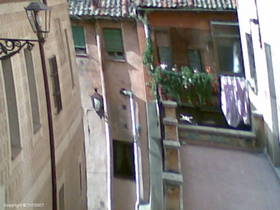 |
No such bar exists that makes bad coffee:
every place has its own coffee machine and the drink is made to order.
The default size of beer is really small, 25cl. It's ok if you don't want to ruin your beer sitting on the patio in warm temperatures, but it wastes a lot of glass, in case you are buying beer home in bottles. | Restaurants and bars are either non-smoking or fully smoking: a non-smoking section is totally unheard of. |
| People greet strangers in the streets, even if these are doing
something weird as running early in the morning.
People also have this awkward habit of kissing everyone when greeting, even strangers. |
 |
In general, people do not speak English, even if their job is in the tourist information center. |